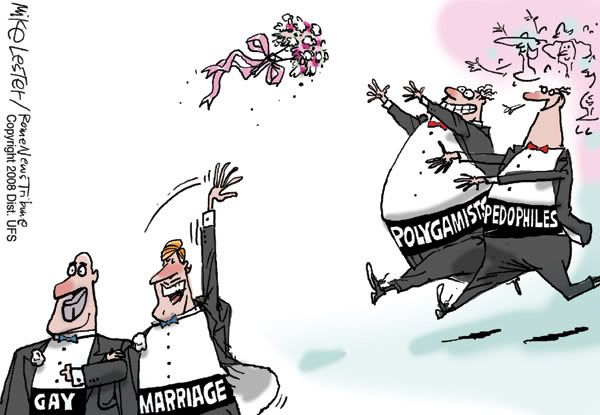According to Purdue University's online writing lab, explains slippery slope as "This is a conclusion based on the premise that if A happens, then eventually through a series of small steps, through B, C,..., X, Y, Z will happen, too, basically equating A and Z." When someone uses the slippery slope fallacy to prove a point, they try to make an argument that if one situation happens or doesn't happen, then it will lead to another situation that may have a higher level of seriousness or risk. The slippery slope is a fallacy because the person making the argument has no logical reasoning behind their statements.
Slippery slope fallacies are very popular within the American culture today. Most commonly in today’s society, the slippery slope is used during arguments on gay rights, politics, and feminism. Here are some examples of popular cartoons from social media that elucidate the slippery slope fallacy.


In these examples, the illustrators are using satire to make a mockery of the slippery slope fallacy arguments being made in our society. These cartoons persuade readers to think negatively about gay marriage (first picture) and think negatively towards Occupy Wall Street movement (second picture).
The creators use cartoons to try to come off as comical and make fun of slippery slope ideas and thoughts that are within our American society. On the surface, these cartoons may come off as just a silly image, but these cartoons are shining light on a deeper issue of Americans rushing to conclusions without creditable sources. Instead of creating funny cartoons with no meaning, these cartoonists try to display how ridiculous certain individuals or groups may sound like when coming from a slippery slope aspect and not having credible data and resources to back up their conclusions.
In today’s society, social media sites and applications as a whole has become a large part of the American lifestyle. In social media, cartoons such as these examples are either is or on the way to becoming viral and can be found when a user isn't even searching for them. Many teens who are usually impressionable because of their young age and lack of knowledge, use social media constantly. With teenagers as the largest generation category using social media, these cartoons have potential to become the mindset of most teenagers in America because of the popularity of the cartoons. American teens today, often rely on social media as their news and sourcing for political views. Seeing cartoons like these over and over again may alter adolescents’ views because they may view popular cartoons such as these, as popular opinion and believe this is the “right” idea. The slippery slope fallacy cartoons can be powerful in our society because of large social media usage in our American culture but these cartoons may not achieve its goal they were created for. These cartoons were created to make fun of and show how slippery slope ideas based on social issues are nonsenses but without a certain amount of education of the readers these cartoons may be seen as the correct way to view social topics.
I really like your blog post. I never realized how much the fallacy slippery slope is used now a days in society. You had some really good examples. I really like the first image that you had in your post. I look at the post and can clearly see what they are trying to portray. It’s great how you used a hyperlink in your first sentence to show that you got that information from an outside source. Don’t forget to give credit for the images you used in your post. Make sure under each of the images you mention where you got them from.
ReplyDeleteI think this a decent post here and all. You really showed a great example of what slippery slope logical fallacy really is. This what you showed right here is a good example of a slippery slope fallacy within our society. I like the bottom picture between the two which shows the cartoon slippery slope fallacy of Occupying Wall Street would lead to occupying private properties, businesses, and capitalism. Yet the bottom picture showed it to be a negative thing but honestly to me I think some it is positive because I think we should occupy some of the bias and poisoned parts of the media that are usually dishonest and would slander or exaggerate things badly. I also think we should occupy some parts of the government especially the federal government. I'm short of sick and tired of those pro-establishment people in Washington and Wall Street. All of that needs to be changed or fixed.
ReplyDeleteBut I'm not trying to sound radical about it but it's true that there needs to be a confrontation towards the media and the pro-establishment people in Washington and Wall Street.
ReplyDelete